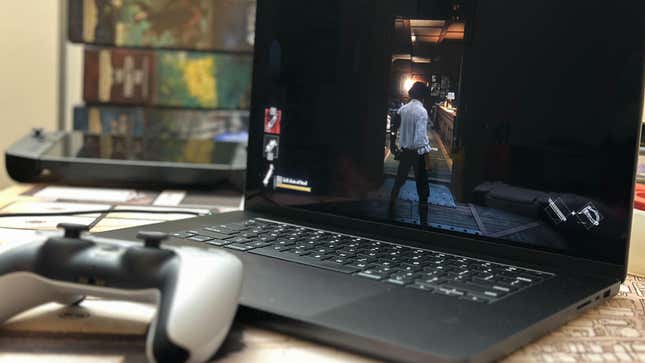MacBook Pro Review in Progress: Powerful, Sleek, Same
Note: this is still a review in progress, so we’re giving it our 4/5 rating, and we’ll be coming back to share how well the battery and screen brightness holds up. Check back with us in the coming days for the full score.
There are few things in tech writing that feel as good as booting up a powerful computer. It’s as close as people in my line of work can get to flipping the switch to fire up a two-stage sub-orbital rocket engine.
When you boot up the 16-inch MacBook Pro with the new M3 Max chip running 48 GB of RAM, it’s like sitting in the captain’s chair of the Enterprise. It boots and runs like a dream. Possibilities buzz with electricity around your fingertips as you move to start using it. Yes, the MacBook Pro is still good. Yes, the M3 is the best version of the MacBook Pro. And yes, Bruce, it does come in black.
But, like in rocket design, knowing how powerful your engine is doesn’t matter as much as what you’re going to use it for. I know the MacBook Pro is a powerful beast, but stick it in High Power mode, and the fans start going so fast they sound like they’re about to generate lift, drawing a concerned look from my roommate sitting in the room near me. It also drains the laptop’s battery from full to null in just about two hours if you leave it unplugged.
This is a powerful and expensive laptop meant for productivity tasks that require a lot of GPU power and memory, but it’s a little overkill for much below that. It can also support a fair amount of gaming potential, though it remains limited by a lack of Mac-supporting games.
Apple declared its newest M3-powered products were “scary fast” during an event bearing the same name. They are, indeed, powerful machines, and all the benchmarks we were able to run prove that. Yet the MacBook Pro is most comfortable when it’s running like it always has, for intensive tasks that allow users a fair bit of wiggle room so you’re not overtaxing your device. It can effectively power some heavy-duty rendering programs with ease. The M3 is, indeed, a more powerful chip than the M2. But depending on the user, that might not change much—or anything—about how you use Apple’s laptops sporting the company’s own silicon.
In my first impressions of the Pro last month, I thought Apple was aiming this machine for the market of MacBook users who haven’t made the switch away from Intel chips. I would modify that now. Apple is also trying to promote its latest ultra-powered laptop as a quality workstation as well as a gaming PC. This is Apple’s burgeoning use case for Mac. The problem is the Mac ecosystem still lacks the support of the most major game makers. It’s pure disappointment to scroll through my entire Steam library to find only a handful of games, most of them a few years old, that don’t have a dreaded “Available for Windows” sticker on them.
Most of the same critiques we had with the M2-powered MacBook Pro, which came out earlier this year, remain the same. The camera notch is still annoying. There’s still no touchscreen or many overt display improvements over past generations. Simply put, it’s an iteration of what already worked for the M1-powered MacBook, but is that enough to sell current MacBook users a whole new laptop generation? Considering that this is the second all-new MacBook Pro model released this year, I hope Apple takes far more time to innovate on the next laptop model.
MacBook Pro 16-inch M3 Max MacBook Pro Screen and Sound
Other Than a New Coat of Paint, the MacBook Pro Still Looks and Sounds the Same

Let’s get the externals out of the way. The “Space Black” shell on the MacBook Pro is a real purty color for Apple’s laptops. There are only so many times you can go for a light or dark gray before every new MacBook starts looking like it came out of a slate factory. The new color includes an anodized seal on the sides and back that Apple promises should reduce fingerprints. I can say with all my travels, I haven’t managed to spot a single smudge on the MacBook’s shell. Who’s to say how long that will last? But for now, Apple’s latest coat of paint is easily my favorite.
If it weren’t for the new black color, the M3-powered MacBook Pro would look exactly like the M2-powered version that arrived earlier this year. The screen is still the Apple-brand “Liquid Retina” display, though now it claims to have 600 nits of SDR brightness compared to 500 from Apple’s last Pro laptop. The “ProMotion” 120 Hz variable refresh rate offers a healthy display for watching Netflix or YouTube, but that’s nothing you haven’t already seen on Apple’s laptops.
Apple still has the best automatic brightness settings in the business. Looking and listening to music on the MacBook Pro is still a pleasure. The six-speaker system on the Mac supports spatial audio, and yes, there’s a subtle but noticeable distinctiveness to Apple sound compared to other brands.
We’re still working to test the brightness and battery life of the device. Apple promises up to 18 hours of movie playback and up to 12 hours of browsing on the M3 Max chip (you get a few more hours of battery life on the regular M3 and M3 Pro). That said, running more high-powered tasks like rendering or gaming will drain the battery in a matter of hours.
The notch is still there, hovering like a black spot on Apple’s efforts to eliminate bezels across its slate of devices. Though the iPhone 14 Pro’s Dynamic Island didn’t have much support at launch, it’s grown into a feature I honestly like on the Cupertino, California company’s latest smartphones. It would be nice to have something similar to it on the Mac, though that might also necessitate a touchscreen, something Apple has also been loathe to do with its laptop brands.
The 1080p webcam remains effectively unchanged despite claims it can subtly fix white balance and noise thanks to the M3 chip. The same goes for the low-profile keyboard and large trackpad. The M2 MacBook Pro moved to HDMI 2.1, and that support remains unchanged on this new device. The 16-inch version of the MacBook Pro also gets two USB-C ports instead of the two on the less-expensive models. My ultra-expensive M3 Max laptop came with the 140W charging brick and braided cable. Charging from near-empty to full took about an hour with the fast-charging cable.
M3 MacBook Pro 16 Benchmarks
The M3 Max Chip is an Absolute Performance Beast

The MacBook Pro was designed from the get-go for high-end productivity and creation tasks. In this regard, the M3 Max chip is some of the best in its class. We were granted the 48 GB RAM version of the 16-inch pro, though the company is also advertising a laptop with an eye-popping 128 GB. There’s a bit of confusion with what comes with each chip at each price point. Our M3 Max has a 16-core CPU and 40-core GPU, but you spend $500 less for the 36GB of unified memory, and you get a 14-core CPU and 30-core GPU. The core values are the same if you opt for the sub-$3,000 M3 Pro-powered 16-inch MacBook Pros.
The M3 Max Chip scores well into the top 20% of CPUs for the Blender 3.6 benchmark. We unfortunately don’t have the highest power M2 chip on hand to compare the M3 Max to directly, but it took just 30 seconds to render Blender’s older BMW test benchmark. We last recorded it took the M2-powered laptop around two minutes and 30 seconds. It took an older M1 Max chip more than four minutes to render the same. Our encoding test using HandBrake was similarly fast, taking 40 seconds to transcode a 4K video to 1080p compared to the M2’s 2-minute, 22 seconds.
On the latest version of the Cinebench, which tests how well a system can render a scene, the M3 easily eclipsed scores for the best laptop-based M1 chips. On Geekbench 6, the M3 Max can hold its own with several big-brand gaming laptops and takes the cake over the 2022 13-inch MacBook Pro with M2.
That’s all to say: the $3,999 laptop is a monster of a machine that can handle desktop-level tasks on a laptop, and that’s without the extra 80 GB of RAM on top of what comes with the most-expensive M3 Max you can buy.
Gaming on the 16-Inch MacBook Pro
The M3 Max Chip Sure Can Play Games on High Settings if You Can Find any that Support Mac

Apple is pushing the gaming functionality of its new MacBooks pretty hard. The latest MacOS Sonoma added a new “Game Mode” to offer better FPS in-game by scaling back all unnecessary tasks. Windows already offers similar features, and it’s something that’s to be expected on any OS meant for gaming.
Apple promoted two new games to test the new MacBook Pro, Baldur’s Gate III and Lies of P. BG3 can indeed offer some strong benchmarks, as when you put it at high settings, it can stress out mid-to-upper range PCs with all settings running, especially at latter parts of the game. I was getting upwards of 130 FPS in the wilderness during Act 1, and it only dipped to the low 70s when strolling through Act 3, where there are far more NPCs on screen.
Lies of P, on the other hand, isn’t exactly the kind of software to push the limits of graphical fidelity. I set it to the highest setting possible, on High Power mode, mind you, and managed an average of 70 FPS in the game’s outdoor settings. Lies is a fine-looking game, but it’s a mid-budget Souls-like that’s not really made to push hardware to the limits. Lies of P don’t have real-time reflections and not too many in-game settings that can really show off the M3 chip’s new support for hardware-accelerated ray tracing.
The lack of games that support Mac makes it hard to benchmark some of the most demanding titles from the past few years, such as Cyberpunk: 2077. Of course, there are a few older titles like Resident Evil: Village or Death Stranding: Director’s Cut, but anybody who’s already wanted to play those games likely already has. I tried cranking the settings on games like Total War: Warhammer II and Total War: Three Kingdoms and managed to manage both games on the highest settings easily. Note those games haven’t been explicitly optimized for the M3 chip.
At $4,000, the 48 GB RAM model of the MacBook Pro competes directly with full-powered gaming laptops like the Razer Blade 16 or the Acer Helios 18, both of them Windows PCs with hardware specifically engineered and optimized for playing the latest games. Mac is only just getting its gaming sea legs, and I truly want to see a day when far more games are released concurrently with consoles, Windows, and Mac platforms. We’re not there yet, but I hope this device can push other developers to consider developing more games on the Mac ecosystem.
If you’re still using a formerly powerful Intel chip-based MacBook Pro, the M3 version is the most enticing reason to switch to Apple’s M-series yet. If you have an M1-powered laptop, it will be up to each individual whether faster processors are worth dropping upwards of $3,500 on a new Mac. If you were going into the MacBook Pro thinking it would be good for gaming, know you will be effectively constrained by what games you can play.
I would still recommend the latest MacBook if you want to see what all the fuss is about with Apple’s M-series ecosystem. Otherwise, if you were looking for some dramatic change up of the MacBook Pro’s design, you still might wait for OLED if you can stand waiting at least a full year or more for dramatically improved displays.
